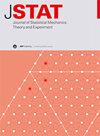Frustration—no frustration crossover and phase transitions in 2D spin models with zig-zag structures
IF 1.9
3区 物理与天体物理
Q2 MECHANICS
Journal of Statistical Mechanics: Theory and Experiment
Pub Date : 2024-05-01
DOI:10.1088/1742-5468/ad3a5d
引用次数: 0
Abstract
Three 2D spin models made of frustrated zig-zag chains with competing interactions which, by exact summation with respect to some degrees of freedom, can be replaced by an effective temperature-dependent interaction, were considered. The first model, exactly solvable Ising chains coupled by only four-spin interactions, does not exhibit any finite temperature phase transition; nevertheless, temperature can trigger a frustration–no frustration crossover accompanied by gigantic specific heat. A similar effect was observed in several two-leg ladder models (Weiguo 2020 arXiv:具有之字形结构的二维自旋模型中的受挫-无受挫交叉和相变
研究考虑了三种二维自旋模型,它们由具有竞争相互作用的沮陷之字链组成,通过对某些自由度的精确求和,这些相互作用可以被有效的温度相关相互作用所取代。第一个模型是仅由四自旋相互作用耦合的精确可解伊辛链,它没有表现出任何有限温度相变;然而,温度会引发沮度-非沮度交叉,并伴随着巨大的比热。在一些两腿梯形模型中也观察到了类似的效应(魏国,2020 arXiv:2006.08921v2;2020 2006.15087v1)。利用精确的昂萨格方程和线性扰动重正化群(LPRG)分析了各向异性伊辛链与链间的直接相互作用以及链间自旋的间接相互作用。根据参数设置的不同,这种模型表现出一种反铁磁性(AF)或铁磁性(FM)相变,或三种相变,其中在 AF 和 FM 相变之间有一个重入无序相。LPRG 方法还用于研究耦合单轴 XXZ 链,例如,它可以作为描述铀和稀土原子形成之字链的化合物磁性能的最小模型。与伊辛模型一样,在一定的参数设置下,该模型可以发生三种相变。然而,链内和链间的平素相互作用 si,jxsk,lx+si,jysk,ly 可以消除再入无序相,这时只发生一种转变。此外,XXZ 模型还可能发生温度诱导的元磁转变。
本文章由计算机程序翻译,如有差异,请以英文原文为准。
求助全文
约1分钟内获得全文
求助全文
来源期刊
CiteScore
4.50
自引率
12.50%
发文量
210
审稿时长
1.0 months
期刊介绍:
JSTAT is targeted to a broad community interested in different aspects of statistical physics, which are roughly defined by the fields represented in the conferences called ''Statistical Physics''. Submissions from experimentalists working on all the topics which have some ''connection to statistical physics are also strongly encouraged.
The journal covers different topics which correspond to the following keyword sections.
1. Quantum statistical physics, condensed matter, integrable systems
Scientific Directors: Eduardo Fradkin and Giuseppe Mussardo
2. Classical statistical mechanics, equilibrium and non-equilibrium
Scientific Directors: David Mukamel, Matteo Marsili and Giuseppe Mussardo
3. Disordered systems, classical and quantum
Scientific Directors: Eduardo Fradkin and Riccardo Zecchina
4. Interdisciplinary statistical mechanics
Scientific Directors: Matteo Marsili and Riccardo Zecchina
5. Biological modelling and information
Scientific Directors: Matteo Marsili, William Bialek and Riccardo Zecchina

 求助内容:
求助内容: 应助结果提醒方式:
应助结果提醒方式:


